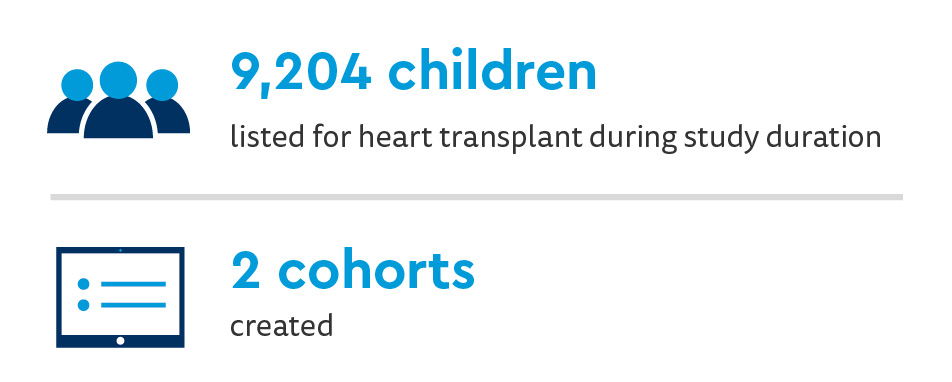Key takeaways
-
This study compared heart transplant outcomes for children with heterotaxy to children with other types of CHD for a period of 25 years.
-
Heterotaxy was a predictor of early post-transplant mortality in the earliest era (1993-2004), but survival improved over time when ranked by era.
-
While mortality risks after transplant decreased between 2004 and 2018, early referrals could improve waitlist outcomes.
Research background: outcomes for CHD patients with heterotaxy after heart transplant listing, transplantation
Children born with a complex congenital heart disease (CHD) not treatable with medication or surgery may need a heart transplant. Unfortunately, patients with CHD experience worse outcomes after heart transplant than those with other conditions. What is not known are the outcomes associated with specific types of CHD after listing for a heart transplant, including other syndromes and systemic anomalies.
Patients with a rare type of CHD called heterotaxy syndrome (HS) are a distinct group of patients referred for heart transplants. Heterotaxy results in a complex, abnormal arrangement of the heart and other organs in the body and abnormal pulmonary venous connections.
The goal of the study was to describe outcomes after heart transplant in CHD patients with heterotaxy, compared to patients with other CHDs (non-HS).
Research methods: analyzing 25 years of heart transplant data for children with CHD, with and without heterotaxy
Data from the international Pediatric Heart Transplant Society (PHTS) registry was analyzed in the study. The Heart Institute at Children’s Hospital Colorado participates in the registry and Melanie Everitt, MD, director of the Pediatric Heart Transplant Program at Children’s Colorado, served as the principal investigator.
Study inclusion criteria
- Children under 18 years old
- Pretransplant CHD diagnosis
- Listed Jan.1, 1993 – Dec. 31, 2018 (follow up complete through Dec. 31, 2019)
The study was divided into two cohorts:

The study also compared outcomes data by eras, defining 1993-2004 as “early era” and 2005-2018 as “recent era.”
Outcomes
- Primary
- Survival after listing (with or without heart transplant)
- Survival after heart transplant
- Secondary
- No rejection
- No infection
- No CAV
- No PTLD
Post-transplant risk factors were identified using multiphase parametric hazard modeling.
Research results: characteristics and outcomes for CHD-HS cohort vs. other CHD cohort

CHD-HS cohort
- 196 with HS (4% of CHD patients)
- 88 had asplenia (45%)
- 78 had unknown (40%)
- 35 had polysplenia (15%)
- 130 received heart transplant (66%)
- 4% of total CHD heart transplant recipients
Other CHD cohort
- 4,618 non-HS CHD (96% of CHD patients)
- 3,131 received heart transplant (68%)
Patient characteristics
Compared to the other CHD cohort, the CHD-HS cohort at time of listing:
- Were older (5.8 ± 5.7 vs. 4.2 ± 5.5 years, p < 0.01)
- More commonly listed as lower urgency (29.8% vs. 18.4%, p < 0.01)
- Less often supported by mechanical ventilation (22% vs. 29.1%, p < 0.05)
- Less frequently required extracorporeal membrane oxygenation (ECMO) support (3.6% vs. 7.5%, p < 0.05)
- Had more single ventricle heart disease (71.3% vs. 59.2%, p < 0.01)
- Differed by palliation stage
- Palliation stage for single ventricle
- No prior surgery (28.1% vs. 27.3%)
- Stage 1 palliation (1.4% vs. 12.5%)
- Stage 2 palliation (28.1% vs. 27.1%)
- Fontan palliation (42.4% vs. 33.1%)
- Palliation stage for single ventricle
- Had significantly higher presence of total anomalous pulmonary venous return (TAPVR) (33% vs. 1.5%)
Compared to the other CHD cohort, the CHD-HS cohort at time of heart transplant:
- Were older (6.4 ± 5.9 years vs. 5.0 ± 5.8 years, p <0.01)
- More often transplanted at the lower urgency status 2 (19.2% vs. 10.1%)
- Less commonly supported by ECMO (1.6% vs. 7.4%, p < 0.01)
- >More often had TAPVR (31.7% vs. 1.4%, p < 0.01)
- Longer cardiopulmonary bypass time (28 minutes difference between means)
- No significant difference among cohorts for:
- History of prior surgery
- Mechanical ventilation
- Use of VAD support
- Donor ischemic times
- Use of induction therapy
- Use of steroids at 30 days post-transplant
Patient outcomes
Compared to the other CHD cohort, survival outcomes of CHD-HS cohort were:
- On waitlist
- No difference among the two cohorts in:
- Transplant
- Death on waitlist
- Removal from list due to deterioration
- No difference among the two cohorts in:
- After listing
- No difference among the two cohorts
- 76% vs. 74% still alive six months after listing
- No difference among the two cohorts
- After transplant
- Survival was significantly worse across entire study period
- 1-year survival (77.2% vs. 85.1%)
- 5-year survival (66.4% vs. 75.4%)
- Both groups experienced improved survival over time, when data stratified by era
- Survival was significantly worse across entire study period
Study authors also identified and evaluated risk factors for each phase.
Independent predictors of early mortality after heart transplant included:
- Level of support or multi-organ failure at the time of transplant
- ECMO support, VAD support, mechanical ventilation and renal failure at transplant were predictors of worse outcome
- Single ventricle heart disease (but was no difference in risk related to HS with or without single ventricle disease)
- Earlier year of transplantation
- HS in early era (not in recent era)
Factors predicting constant phase mortality were different than early phase morality and included:
- Black race
- Prior surgical history
- Status 1 listing at transplant
- HS was an independent risk factor
- Earlier year heart transplant
- No difference in effect of HS within different eras
Secondary outcomes
Compared to the Other CHD cohort, the CHD-HS cohort:
- No difference in time to rejection
- Lower freedom from rejection with hemodynamic compromise
- Difference in time to first infection with lower freedom from infection
- No significant difference in freedom from rom CAV or PTLD
Heterotaxy subgroup analysis: single ventricle disease and polysplenia/asplenia

- 89 (64%) received heart transplant
- 56 had biventricular heart disease
- 41 (73%) received heart transplant
When comparing single ventricle CHD-HS with biventricular CHD-HS, there was no statistical difference in survival after listing or transplant.
Compared to the CHD-HS with polysplenia group, the CHD-HS asplenia group:
- At listing
- More prior surgery (88% vs. 70%, p < 0.05)
- More had single ventricle CHD (78% vs. 50, p < 0.05)
- More had TAPVR (42% vs. 15%, p = 0.01)
- Less likely to receive ventilator support (10.7% vs. 32.1%, p < 0.01)
- On waitlist
- Comparable survival
- Post-transplant
- Significantly better early post-transplant survival
- No survival difference overall when followed to 5 years
Research discussion and conclusion: new findings of differences in era for mortality of CHD patients with heterotaxy
The study provides detailed analysis of listing and post-transplant outcomes in children with CHD and HS. Some findings were consistent to those of earlier studies, including:
- CHD-HS group more commonly listed at a lower urgency status, less likely to require mechanical ventilation and ECMO support, but death while listed was same as Other CHD listed group
- CHD-HS group experienced higher death rates after HT
- Possibly because children with heart failure due to single ventricle CHD may not be eligible for advanced therapies while listed
- Single ventricle heart disease was a risk factor for early post-transplant mortality for the entire CHD cohort with and without HS
- These findings with other study findings may suggest considering higher risk un-operated infants with CHD-HS for primary HT and progressing lower risk single ventricle CHD-HS through staged palliation
- Most applicable if survived initial neonatal period and first stage palliation
- Most deaths occurred within 3 months after HT
An additional notable finding was that patients with CHD-HS had lower freedom from rejection with hemodynamic compromise. Prior PHTS analyses showed poor survival after an episode of rejection with hemodynamic compromise.
Novel findings
A new and important finding was era differences. Analysis of era differences found the early mortality risk associated with HS was mitigated in the recent era of HT.
- Effect of HS on early mortality risk was greatest in the early era of HT, but moderated in recent transplant era
- Those who underwent HT before 2005 faced a 2-fold higher risk of early death compared to children without HS and without early era HT
- Survival was worse after HT in polysplenia, but difference was negated in current era
- Advancement in surgical techniques and pre-operative imaging for candidate selection and surgical planning may have contributed to dramatic improvement in early heart transplant survival in CHD-polysplenia
Early referral may improve heart transplant waitlist outcomes for heterotaxy patients who otherwise have a lower status at listing, but similar waitlist outcomes compared to other CHD candidates. Lower freedom from both infection and severe rejection after transplant in heterotaxy highlights the challenges of balancing immune suppression. Study results show favorable outcomes for children with heterotaxy in the current era of heart transplant.
Featured Researchers

Melanie Everitt, MD
Director of Pediatric Heart Transplant
The Heart Institute
Children's Hospital Colorado
Professor
Pediatrics-Cardiology
University of Colorado School of Medicine





 720-777-0123
720-777-0123










